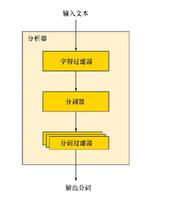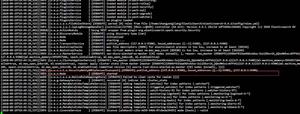如何在elasticsearch中配置同义词_路径
我是Elasticsearch的新手,我想使用同义词,我在配置文件中添加了以下几行:
index : analysis :
analyzer :
synonym :
type : custom
tokenizer : whitespace
filter : [synonym]
filter :
synonym :
type : synonym
synonyms_path: synonyms.txt
然后我创建了一个索引测试:
"mappings" : { "test" : {
"properties" : {
"text_1" : {
"type" : "string",
"analyzer" : "synonym"
},
"text_2" : {
"search_analyzer" : "standard",
"index_analyzer" : "synonym",
"type" : "string"
},
"text_3" : {
"type" : "string",
"analyzer" : "synonym"
}
}
}
}
并使用以下数据插入类型测试:
{"text_3" : "foo dog cat",
"text_2" : "foo dog cat",
"text_1" : "foo dog cat"
}
onymousy.txt包含“ foo,bar,baz”,当我搜索foo时,它返回我期望的结果,但是当我搜索baz或bar时,它返回零结果:
{"query":{
"query_string":{
"query" : "bar",
"fields" : [ "text_1"],
"use_dis_max" : true,
"boost" : 1.0
}}}
结果:
{"took":1,
"timed_out":false,
"_shards":{
"total":5,
"successful":5,
"failed":0
},
"hits":{
"total":0,
"max_score":null,
"hits":[
]
}
}
回答:
我不知道,如果您的问题是因为您为“
bar”定义了错误的同义词。正如您所说的,您是一个非常新的人,我将举一个与您的例子相似的例子。我想展示一下Elasticsearch在搜索时和索引时如何处理同义词。希望能帮助到你。
首先,创建同义词文件:
foo => foo bar, baz现在,我使用您要测试的特定设置创建索引:
curl -XPUT 'http://localhost:9200/test/' -d '{ "settings": {
"index": {
"analysis": {
"analyzer": {
"synonym": {
"tokenizer": "whitespace",
"filter": ["synonym"]
}
},
"filter" : {
"synonym" : {
"type" : "synonym",
"synonyms_path" : "synonyms.txt"
}
}
}
}
},
"mappings": {
"test" : {
"properties" : {
"text_1" : {
"type" : "string",
"analyzer" : "synonym"
},
"text_2" : {
"search_analyzer" : "standard",
"index_analyzer" : "standard",
"type" : "string"
},
"text_3" : {
"type" : "string",
"search_analyzer" : "synonym",
"index_analyzer" : "standard"
}
}
}
}
}'
请注意,onymous.txt必须与配置文件位于同一目录中,因为该路径相对于config目录。
现在为文档编制索引:
curl -XPUT 'http://localhost:9200/test/test/1' -d '{ "text_3": "baz dog cat",
"text_2": "foo dog cat",
"text_1": "foo dog cat"
}'
现在搜索
curl -XGET 'http://localhost:9200/test/_search?q=text_1:baz'{
"took": 3,
"timed_out": false,
"_shards": {
"total": 5,
"successful": 5,
"failed": 0
},
"hits": {
"total": 1,
"max_score": 0.15342641,
"hits": [
{
"_index": "test",
"_type": "test",
"_id": "1",
"_score": 0.15342641,
"_source": {
"text_3": "baz dog cat",
"text_2": "foo dog cat",
"text_1": "foo dog cat"
}
}
]
}
}
您得到该文档,因为baz是foo的同义词,并且在索引时间foo用其同义词扩展
curl -XGET 'http://localhost:9200/test/_search?q=text_2:baz'结果:
{ "took": 2,
"timed_out": false,
"_shards": {
"total": 5,
"successful": 5,
"failed": 0
},
"hits": {
"total": 0,
"max_score": null,
"hits": []
}
}
我没有获得成功,因为我在索引(标准分析器)时没有扩展同义词。而且,由于我正在搜索baz,并且baz不在文本中,所以没有任何结果。
curl -XGET 'http://localhost:9200/test/_search?q=text_3:foo'{
"took": 3,
"timed_out": false,
"_shards": {
"total": 5,
"successful": 5,
"failed": 0
},
"hits": {
"total": 1,
"max_score": 0.15342641,
"hits": [
{
"_index": "test",
"_type": "test",
"_id": "1",
"_score": 0.15342641,
"_source": {
"text_3": "baz dog cat",
"text_2": "foo dog cat",
"text_1": "foo dog cat"
}
}
]
}
}
注意:text_3是“巴兹狗猫”
text_3是没有扩展同义词的索引。当我搜索foo时,它的同义词之一是“ baz”,我得到了结果。
如果要调试,可以使用_analyze端点,例如:
curl -XGET 'http://localhost:9200/test/_analyze?text=foo&analyzer=synonym&pretty=true'结果:
{ "tokens": [
{
"token": "foo",
"start_offset": 0,
"end_offset": 3,
"type": "SYNONYM",
"position": 1
},
{
"token": "baz",
"start_offset": 0,
"end_offset": 3,
"type": "SYNONYM",
"position": 1
},
{
"token": "bar",
"start_offset": 0,
"end_offset": 3,
"type": "SYNONYM",
"position": 2
}
]
}
以上是 如何在elasticsearch中配置同义词_路径 的全部内容, 来源链接: utcz.com/qa/403762.html








